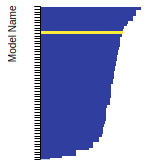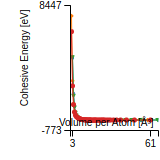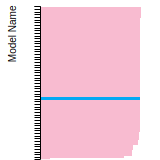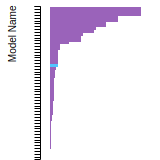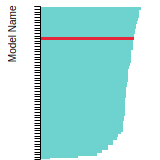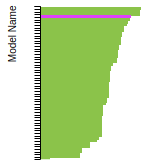 MFF_MistriotisFlytzanisFarantos_1989_Si__MO_080526771943_001
MFF_MistriotisFlytzanisFarantos_1989_Si__MO_080526771943_001
| Title
A single sentence description.
|
MFF potential for Si developed by Mistriotis, Flytzanis and Farantos (1989) v001 |
|---|---|
| Description
A short description of the Model describing its key features including for example: type of model (pair potential, 3-body potential, EAM, etc.), modeled species (Ac, Ag, ..., Zr), intended purpose, origin, and so on.
|
An interatomic potential for silicon is proposed, which is a significant improvement over the Stillinger-Weber model. This potential is valid for clusters with more than six atoms, where pi-bonding is not significant because of the large degree of coordination. Guided by ab initio electronic calculations, we introduced four-body interactions to the potential, which were essential to give good agreement with the melting point of the crystal and the geometries and the energies of the ground and low metastable states of silicon clusters. |
| Species
The supported atomic species.
| Si |
| Disclaimer
A statement of applicability provided by the contributor, informing users of the intended use of this KIM Item.
|
None |
| Contributor |
Amit K. Singh |
| Maintainer |
Amit K. Singh |
| Developer |
Nikos Flytzanis Stavros C. Farantos Antonis D Mistriotis |
| Published on KIM | 2018 |
| How to Cite |
This Model originally published in [1] is archived in OpenKIM [2-5]. [1] Mistriotis AD, Flytzanis N, Farantos SC. Potential model for silicon clusters. Physical Review B. 1989Jan;39(2):1212–8. doi:10.1103/PhysRevB.39.1212 — (Primary Source) A primary source is a reference directly related to the item documenting its development, as opposed to other sources that are provided as background information. [2] Flytzanis N, Farantos SC, Mistriotis AD. MFF potential for Si developed by Mistriotis, Flytzanis and Farantos (1989) v001. OpenKIM; 2018. doi:10.25950/ae53f73a [3] Singh AK, Mistriotis AD, Flytzanis N, Farantos SC, Tadmor EB, Miller RE. Four-body Mistriotis-Flytzanis-Farantos (MFF) model driver v001. OpenKIM; 2018. doi:10.25950/bdc45775 [4] Tadmor EB, Elliott RS, Sethna JP, Miller RE, Becker CA. The potential of atomistic simulations and the Knowledgebase of Interatomic Models. JOM. 2011;63(7):17. doi:10.1007/s11837-011-0102-6 [5] Elliott RS, Tadmor EB. Knowledgebase of Interatomic Models (KIM) Application Programming Interface (API). OpenKIM; 2011. doi:10.25950/ff8f563a Click here to download the above citation in BibTeX format. |
| Citations
This panel presents information regarding the papers that have cited the interatomic potential (IP) whose page you are on. The OpenKIM machine learning based Deep Citation framework is used to determine whether the citing article actually used the IP in computations (denoted by "USED") or only provides it as a background citation (denoted by "NOT USED"). For more details on Deep Citation and how to work with this panel, click the documentation link at the top of the panel. The word cloud to the right is generated from the abstracts of IP principle source(s) (given below in "How to Cite") and the citing articles that were determined to have used the IP in order to provide users with a quick sense of the types of physical phenomena to which this IP is applied. The bar chart shows the number of articles that cited the IP per year. Each bar is divided into green (articles that USED the IP) and blue (articles that did NOT USE the IP). Users are encouraged to correct Deep Citation errors in determination by clicking the speech icon next to a citing article and providing updated information. This will be integrated into the next Deep Citation learning cycle, which occurs on a regular basis. OpenKIM acknowledges the support of the Allen Institute for AI through the Semantic Scholar project for providing citation information and full text of articles when available, which are used to train the Deep Citation ML algorithm. |
This panel provides information on past usage of this interatomic potential (IP) powered by the OpenKIM Deep Citation framework. The word cloud indicates typical applications of the potential. The bar chart shows citations per year of this IP (bars are divided into articles that used the IP (green) and those that did not (blue)). The complete list of articles that cited this IP is provided below along with the Deep Citation determination on usage. See the Deep Citation documentation for more information. 
42 Citations (2 used)
Help us to determine which of the papers that cite this potential actually used it to perform calculations. If you know, click the .
USED (low confidence) A. Mazzone, “FRAGMENTATION, COALESCENCE AND DEPOSITION OF SILICON CLUSTERS STUDIED BY MOLECULAR DYNAMICS,” International Journal of Modern Physics C. 2001. link Times cited: 0 Abstract: Cluster deposition is a technique recently developed for the… read more USED (low confidence) A. Mazzone, “Motions of Si(100) Steps at Low Temperature. A Study by Molecular Dynamics,” MRS Proceedings. 2002. link Times cited: 0 Abstract: An isothermal Molecular Dynamics simulation method has been … read more NOT USED (low confidence) S. Heydariyan, M. R. Nouri, M. Alaei, Z. Allahyari, and T. Niehaus, “New candidates for the global minimum of medium-sized silicon clusters: A hybrid DFTB/DFT genetic algorithm applied to Si n , n = 8-80.,” The Journal of chemical physics. 2018. link Times cited: 7 Abstract: In this study, we perform a systematic search to find the po… read more NOT USED (low confidence) A. Lipnitskii and V. Saveliev, “Development of n-body expansion interatomic potentials and its application for V,” Computational Materials Science. 2016. link Times cited: 20 NOT USED (low confidence) A. Tekin and B. Hartke, “GLOBAL GEOMETRY OPTIMIZATION OF SILICON CLUSTERS EMPLOYING EMPIRICAL POTENTIALS, DENSITY FUNCTIONALS, AND AB INITIO CALCULATIONS,” Journal of Theoretical and Computational Chemistry. 2005. link Times cited: 13 Abstract: Sin clusters in the size range n = 4–30 have been investigat… read more NOT USED (low confidence) A. Mazzone, “Cluster beam steering onto silicon surfaces studied by molecular dynamics,” Nuclear Instruments & Methods in Physics Research Section B-beam Interactions With Materials and Atoms. 2002. link Times cited: 2 NOT USED (low confidence) P. Keblinski, M. Bazant, R. Dash, and M. Treacy, “Thermodynamic behavior of a model covalent material described by the environment-dependent interatomic potential,” Physical Review B. 2002. link Times cited: 38 Abstract: Using molecular-dynamics simulations we study the thermodyna… read more NOT USED (low confidence) B. Liu et al., “Ionization of medium-sized silicon clusters and the geometries of the cations,” Journal of Chemical Physics. 1998. link Times cited: 132 Abstract: We have performed a systematic ground state geometry search … read more NOT USED (low confidence) A. Mazzone, “AN EXTENSION OF THE LCAO METHOD ISOTHERMAL DYNAMICS,” International Journal of Modern Physics C. 1998. link Times cited: 0 Abstract: This work presents a dynamical version of the LCAO method wh… read more NOT USED (low confidence) E. Kaxiras, “Review of atomistic simulations of surface diffusion and growth on semiconductors,” Computational Materials Science. 1996. link Times cited: 17 NOT USED (low confidence) A. A. Valuev, A. S. Kaklyugin, and H. E. Norman, “Molecular modelling of the chemical interaction of atoms and molecules with a surface,” Russian Chemical Reviews. 1995. link Times cited: 3 Abstract: The modelling of a surface as an assembly of moving atoms in… read more NOT USED (low confidence) P. T. Dinda, G. Vlastou-Tsinganos, N. Flytzanis, and A. Mistriotis, “The melting behaviour of small silicon clusters,” Physics Letters A. 1994. link Times cited: 6 NOT USED (low confidence) A. Mistriotis, A. Zdetsis, G. Froudakis, and M. Menon, “Reproduction of quantum tight-binding effects in silicon clusters by a four-body classical model,” Journal of Physics: Condensed Matter. 1993. link Times cited: 0 Abstract: The results obtained by a recently proposed empirical potent… read more NOT USED (low confidence) C. S. Carmer, B. Weiner, and M. Frenklach, “Molecular dynamics with combined quantum and empirical potentials: C2H2 adsorption on Si(100),” Journal of Chemical Physics. 1993. link Times cited: 71 Abstract: Classical trajectory calculations were employed to study the… read more NOT USED (low confidence) A. Vegiri and S. Farantos, “Classical dynamics of hydrogen bonded systems : water clusters,” Journal of Chemical Physics. 1993. link Times cited: 65 Abstract: The minimum energy structures and the classical dynamics of … read more NOT USED (low confidence) K. Raghavachari and C. Rohlfing, “Structures of Si10. Are there conventionally bonded low-energy isomers?,” Chemical Physics Letters. 1992. link Times cited: 53 NOT USED (low confidence) W. Niessen and V. G. Zakrzewski, “Complex Electron Affinity Processes in Clusters of S and Si.” 1992. link Times cited: 2 Abstract: Vertical and in some cases adiabatic electron affinities are… read more NOT USED (low confidence) R. Smith, “A semi-empirical many-body interatomic potential for modelling dynamical processes in gallium arsenide,” Nuclear Instruments & Methods in Physics Research Section B-beam Interactions With Materials and Atoms. 1992. link Times cited: 55 NOT USED (low confidence) R. Virkkunen, K. Laasonen, and R. Nieminen, “Molecular dynamics using the tight-binding approximation: application to liquid silicon,” Journal of Physics: Condensed Matter. 1991. link Times cited: 32 Abstract: The authors present molecular dynamical simulations of liqui… read more NOT USED (low confidence) E. Blaisten-Barojas and M. Nyden, “Molecular dynamics study of the depolymerization reaction in simple polymers,” Chemical Physics Letters. 1990. link Times cited: 12 NOT USED (low confidence) T. Rantala, M. Stockman, D. A. Jelski, and T. George, “Linear and nonlinear optical properties of small silicon clusters,” Journal of Chemical Physics. 1990. link Times cited: 28 Abstract: Electronic contributions to the optical properties of small … read more NOT USED (low confidence) K. Raghavachari, “Theoretical studies on silicon clusters,” Phase Transitions. 1990. link Times cited: 48 Abstract: This is a brief review of the theoretical studies which have… read more NOT USED (low confidence) J. F. Justo, M. Bazant, E. Kaxiras, V. Bulatov, and S. Yip, “Interatomic Potential for Condensed Phases and Bulk Defects in Silicon,” MRS Proceedings. 1997. link Times cited: 5 NOT USED (low confidence) J. Murrell, “Towards a general strategy for global interatomic potentials for elemental solids, surfaces and clusters,” Philosophical Magazine Part B. 1996. link Times cited: 6 Abstract: A review is given of studies that have been made by the Suss… read more NOT USED (low confidence) R. Smith and R. Webb, “Atomic collisions in semiconductors,” Radiation Effects and Defects in Solids. 1994. link Times cited: 1 Abstract: Energetic particle bombardment of semi-conductors (Si and Ga… read more NOT USED (low confidence) D. Wales and M. C. Waterworth, “Structures and rearrangements of model silicon clusters,” Journal of the Chemical Society, Faraday Transactions. 1992. link Times cited: 12 Abstract: We present a study of small silicon clusters bound by the em… read more NOT USED (low confidence) S. Li, R. Johnston, and J. Murrell, “Cluster structures and stabilities from solid-state potentials. Application to silicon clusters,” Journal of the Chemical Society, Faraday Transactions. 1992. link Times cited: 40 Abstract: An empirical potential-energy function comprising two- and t… read more NOT USED (low confidence) K. Laasonen and R. Nieminen, “Molecular Dynamics and Tight-Binding.” 1990. link Times cited: 0 NOT USED (high confidence) Y. Lysogorskiy, T. Hammerschmidt, J. Janssen, J. Neugebauer, and R. Drautz, “Transferability of interatomic potentials for molybdenum and silicon,” Modelling and Simulation in Materials Science and Engineering. 2019. link Times cited: 14 Abstract: Interatomic potentials are widely used in computational mate… read more NOT USED (high confidence) B.-M. Lee, “Thermal Conductivity Analysis of Amorphous Silicon Formed by Natural Cooling: A Molecular-dynamics Study,” Journal of The Korean Ceramic Society. 2016. link Times cited: 0 Abstract: To investigate the thermal conductivity and the structural p… read more NOT USED (high confidence) G. Lucas, M. Bertolus, and L. Pizzagalli, “An environment-dependent interatomic potential for silicon carbide: calculation of bulk properties, high-pressure phases, point and extended defects, and amorphous structures,” Journal of Physics: Condensed Matter. 2010. link Times cited: 41 Abstract: An interatomic potential has been developed to describe inte… read more NOT USED (high confidence) J. Schall, G. Gao, and J. Harrison, “Elastic constants of silicon materials calculated as a function of temperature using a parametrization of the second-generation reactive empirical bond-order potential,” Physical Review B. 2008. link Times cited: 48 Abstract: A parametrization for silicon is presented that is based on … read more NOT USED (high confidence) A. Tekin and B. Hartke, “Global geometry optimization of small silicon clusters with empirical potentials and at the DFT level,” Physical Chemistry Chemical Physics. 2004. link Times cited: 40 Abstract: We have performed global parameter optimization of selected … read more NOT USED (high confidence) M. Schaible, “Empirical Molecular Dynamics Modeling of Silicon and Silicon Dioxide: A Review,” Critical Reviews in Solid State and Materials Sciences. 1999. link Times cited: 28 Abstract: A number of computational methods have been developed over t… read more NOT USED (high confidence) I. Kaplan, R. Santamaria, and O. Novaro, “Nonadditive interactions and the relative stability of neutral and anionic silver clusters,” International Journal of Quantum Chemistry. 1995. link Times cited: 9 Abstract: mWe discuss the physical nature of nonadditivity in many-par… read more NOT USED (high confidence) R. Fournier, S. Sinnott, and A. Depristo, “Density functional study of the bonding in small silicon clusters,” Journal of Chemical Physics. 1992. link Times cited: 90 Abstract: We report the ground electronic state, equilibrium geometry,… read more NOT USED (high confidence) J. Murrell and R. E. Mottram, “Potential energy functions for atomic solids,” Molecular Physics. 1990. link Times cited: 109 Abstract: A potential energy function has been proposed for atomic sol… read more NOT USED (high confidence) K. Laasonen and R. Nieminen, “Molecular dynamics using the tight-binding approximation,” Journal of Physics: Condensed Matter. 1990. link Times cited: 46 Abstract: The authors present an extension of classical molecular dyna… read more NOT USED (high confidence) A. Mazzone, “Molecular dynamics simulations of impact of energetic silicon clusters onto crystalline silicon,” Journal of Computer-Aided Materials Design. 2002. link Times cited: 3 NOT USED (high confidence) I. Kaplan, R. Santamaria, and O. Novaro, “Non-additive forces in atomic clusters,” Molecular Physics. 1995. link Times cited: 41 Abstract: The closed recurrence formula which expresses the energy of … read more NOT USED (high confidence) T. Mittelbach, “Moleküldynamische Untersuchungen an Si-Clustern,” Zeitschrift für Physikalische Chemie. 1992. link Times cited: 1 |
| Funding | Not available |
| Short KIM ID
The unique KIM identifier code.
| MO_080526771943_001 |
| Extended KIM ID
The long form of the KIM ID including a human readable prefix (100 characters max), two underscores, and the Short KIM ID. Extended KIM IDs can only contain alpha-numeric characters (letters and digits) and underscores and must begin with a letter.
| MFF_MistriotisFlytzanisFarantos_1989_Si__MO_080526771943_001 |
| DOI |
10.25950/ae53f73a https://doi.org/10.25950/ae53f73a https://commons.datacite.org/doi.org/10.25950/ae53f73a |
| KIM Item Type
Specifies whether this is a Portable Model (software implementation of an interatomic model); Portable Model with parameter file (parameter file to be read in by a Model Driver); Model Driver (software implementation of an interatomic model that reads in parameters).
| Portable Model using Model Driver MFF__MD_514777050453_001 |
| Driver | MFF__MD_514777050453_001 |
| KIM API Version | 2.0 |
| Potential Type | mff |
| Previous Version | MFF_MistriotisFlytzanisFarantos_1989_Si__MO_080526771943_000 |
| Grade | Name | Category | Brief Description | Full Results | Aux File(s) |
|---|---|---|---|---|---|
| P | vc-species-supported-as-stated | mandatory | The model supports all species it claims to support; see full description. |
Results | Files |
| P | vc-periodicity-support | mandatory | Periodic boundary conditions are handled correctly; see full description. |
Results | Files |
| P | vc-permutation-symmetry | mandatory | Total energy and forces are unchanged when swapping atoms of the same species; see full description. |
Results | Files |
| A | vc-forces-numerical-derivative | consistency | Forces computed by the model agree with numerical derivatives of the energy; see full description. |
Results | Files |
| P | vc-dimer-continuity-c1 | informational | The energy versus separation relation of a pair of atoms is C1 continuous (i.e. the function and its first derivative are continuous); see full description. |
Results | Files |
| P | vc-objectivity | informational | Total energy is unchanged and forces transform correctly under rigid-body translation and rotation; see full description. |
Results | Files |
| P | vc-inversion-symmetry | informational | Total energy is unchanged and forces change sign when inverting a configuration through the origin; see full description. |
Results | Files |
| P | vc-memory-leak | informational | The model code does not have memory leaks (i.e. it releases all allocated memory at the end); see full description. |
Results | Files |
| P | vc-thread-safe | mandatory | The model returns the same energy and forces when computed in serial and when using parallel threads for a set of configurations. Note that this is not a guarantee of thread safety; see full description. |
Results | Files |
| F | vc-unit-conversion | mandatory | The model is able to correctly convert its energy and/or forces to different unit sets; see full description. |
Results | Files |
BCC Lattice Constant
This bar chart plot shows the mono-atomic body-centered cubic (bcc) lattice constant predicted by the current model (shown in the unique color) compared with the predictions for all other models in the OpenKIM Repository that support the species. The vertical bars show the average and standard deviation (one sigma) bounds for all model predictions. Graphs are generated for each species supported by the model.
Cohesive Energy Graph
This graph shows the cohesive energy versus volume-per-atom for the current mode for four mono-atomic cubic phases (body-centered cubic (bcc), face-centered cubic (fcc), simple cubic (sc), and diamond). The curve with the lowest minimum is the ground state of the crystal if stable. (The crystal structure is enforced in these calculations, so the phase may not be stable.) Graphs are generated for each species supported by the model.
Diamond Lattice Constant
This bar chart plot shows the mono-atomic face-centered diamond lattice constant predicted by the current model (shown in the unique color) compared with the predictions for all other models in the OpenKIM Repository that support the species. The vertical bars show the average and standard deviation (one sigma) bounds for all model predictions. Graphs are generated for each species supported by the model.
Dislocation Core Energies
This graph shows the dislocation core energy of a cubic crystal at zero temperature and pressure for a specific set of dislocation core cutoff radii. After obtaining the total energy of the system from conjugate gradient minimizations, non-singular, isotropic and anisotropic elasticity are applied to obtain the dislocation core energy for each of these supercells with different dipole distances. Graphs are generated for each species supported by the model.
(No matching species)FCC Elastic Constants
This bar chart plot shows the mono-atomic face-centered cubic (fcc) elastic constants predicted by the current model (shown in blue) compared with the predictions for all other models in the OpenKIM Repository that support the species. The vertical bars show the average and standard deviation (one sigma) bounds for all model predictions. Graphs are generated for each species supported by the model.
FCC Lattice Constant
This bar chart plot shows the mono-atomic face-centered cubic (fcc) lattice constant predicted by the current model (shown in red) compared with the predictions for all other models in the OpenKIM Repository that support the species. The vertical bars show the average and standard deviation (one sigma) bounds for all model predictions. Graphs are generated for each species supported by the model.
FCC Stacking Fault Energies
This bar chart plot shows the intrinsic and extrinsic stacking fault energies as well as the unstable stacking and unstable twinning energies for face-centered cubic (fcc) predicted by the current model (shown in blue) compared with the predictions for all other models in the OpenKIM Repository that support the species. The vertical bars show the average and standard deviation (one sigma) bounds for all model predictions. Graphs are generated for each species supported by the model.
(No matching species)FCC Surface Energies
This bar chart plot shows the mono-atomic face-centered cubic (fcc) relaxed surface energies predicted by the current model (shown in blue) compared with the predictions for all other models in the OpenKIM Repository that support the species. The vertical bars show the average and standard deviation (one sigma) bounds for all model predictions. Graphs are generated for each species supported by the model.
(No matching species)SC Lattice Constant
This bar chart plot shows the mono-atomic simple cubic (sc) lattice constant predicted by the current model (shown in the unique color) compared with the predictions for all other models in the OpenKIM Repository that support the species. The vertical bars show the average and standard deviation (one sigma) bounds for all model predictions. Graphs are generated for each species supported by the model.
Cubic Crystal Basic Properties Table
Species: SiCreators: Daniel S. Karls
Contributor: karls
Publication Year: 2019
DOI: https://doi.org/10.25950/b47dd4c4
Given an xyz file corresponding to a finite cluster of atoms, this Test Driver computes the total potential energy and atomic forces on the configuration. The positions are then relaxed using conjugate gradient minimization and the final positions and forces are recorded. These results are primarily of interest for training machine-learning algorithms.
Creators:
Contributor: karls
Publication Year: 2019
DOI: https://doi.org/10.25950/64cb38c5
This Test Driver uses LAMMPS to compute the cohesive energy of a given monoatomic cubic lattice (fcc, bcc, sc, or diamond) at a variety of lattice spacings. The lattice spacings range from a_min (=a_min_frac*a_0) to a_max (=a_max_frac*a_0) where a_0, a_min_frac, and a_max_frac are read from stdin (a_0 is typically approximately equal to the equilibrium lattice constant). The precise scaling and number of lattice spacings sampled between a_min and a_0 (a_0 and a_max) is specified by two additional parameters passed from stdin: N_lower and samplespacing_lower (N_upper and samplespacing_upper). Please see README.txt for further details.
| Test | Test Results | Link to Test Results page | Benchmark time
Usertime multiplied by the Whetstone Benchmark. This number can be used (approximately) to compare the performance of different models independently of the architecture on which the test was run.
Measured in Millions of Whetstone Instructions (MWI) |
|---|---|---|---|
| Cohesive energy versus lattice constant curve for bcc Si v004 | view | 3670 | |
| Cohesive energy versus lattice constant curve for diamond Si v004 | view | 6226 | |
| Cohesive energy versus lattice constant curve for fcc Si v004 | view | 3976 | |
| Cohesive energy versus lattice constant curve for sc Si v004 | view | 2356 |
Creators: Junhao Li and Ellad Tadmor
Contributor: tadmor
Publication Year: 2019
DOI: https://doi.org/10.25950/5853fb8f
Computes the cubic elastic constants for some common crystal types (fcc, bcc, sc, diamond) by calculating the hessian of the energy density with respect to strain. An estimate of the error associated with the numerical differentiation performed is reported.
| Test | Test Results | Link to Test Results page | Benchmark time
Usertime multiplied by the Whetstone Benchmark. This number can be used (approximately) to compare the performance of different models independently of the architecture on which the test was run.
Measured in Millions of Whetstone Instructions (MWI) |
|---|---|---|---|
| Elastic constants for bcc Si at zero temperature v006 | view | 6686 | |
| Elastic constants for diamond Si at zero temperature v001 | view | 3423 | |
| Elastic constants for fcc Si at zero temperature v006 | view | 2719 | |
| Elastic constants for sc Si at zero temperature v006 | view | 1631 |
Creators: Junhao Li
Contributor: jl2922
Publication Year: 2019
DOI: https://doi.org/10.25950/d794c746
Computes the elastic constants for hcp crystals by calculating the hessian of the energy density with respect to strain. An estimate of the error associated with the numerical differentiation performed is reported.
| Test | Test Results | Link to Test Results page | Benchmark time
Usertime multiplied by the Whetstone Benchmark. This number can be used (approximately) to compare the performance of different models independently of the architecture on which the test was run.
Measured in Millions of Whetstone Instructions (MWI) |
|---|---|---|---|
| Elastic constants for hcp Si at zero temperature v004 | view | 2324 |
Creators:
Contributor: ilia
Publication Year: 2024
DOI: https://doi.org/10.25950/2f2c4ad3
Computes the equilibrium crystal structure and energy for an arbitrary crystal at zero temperature and applied stress by performing symmetry-constrained relaxation. The crystal structure is specified using the AFLOW prototype designation. Multiple sets of free parameters corresponding to the crystal prototype may be specified as initial guesses for structure optimization. No guarantee is made regarding the stability of computed equilibria, nor that any are the ground state.
Creators: Daniel S. Karls and Junhao Li
Contributor: karls
Publication Year: 2019
DOI: https://doi.org/10.25950/2765e3bf
Equilibrium lattice constant and cohesive energy of a cubic lattice at zero temperature and pressure.
| Test | Test Results | Link to Test Results page | Benchmark time
Usertime multiplied by the Whetstone Benchmark. This number can be used (approximately) to compare the performance of different models independently of the architecture on which the test was run.
Measured in Millions of Whetstone Instructions (MWI) |
|---|---|---|---|
| Equilibrium zero-temperature lattice constant for bcc Si v007 | view | 2239 | |
| Equilibrium zero-temperature lattice constant for diamond Si v007 | view | 8349 | |
| Equilibrium zero-temperature lattice constant for fcc Si v007 | view | 3455 | |
| Equilibrium zero-temperature lattice constant for sc Si v007 | view | 2431 |
Creators: Daniel S. Karls and Junhao Li
Contributor: karls
Publication Year: 2019
DOI: https://doi.org/10.25950/c339ca32
Calculates lattice constant of hexagonal bulk structures at zero temperature and pressure by using simplex minimization to minimize the potential energy.
| Test | Test Results | Link to Test Results page | Benchmark time
Usertime multiplied by the Whetstone Benchmark. This number can be used (approximately) to compare the performance of different models independently of the architecture on which the test was run.
Measured in Millions of Whetstone Instructions (MWI) |
|---|---|---|---|
| Equilibrium lattice constants for hcp Si v005 | view | 129382 |
Creators:
Contributor: mjwen
Publication Year: 2024
DOI: https://doi.org/10.25950/9d9822ec
This Test Driver uses LAMMPS to compute the linear thermal expansion coefficient at a finite temperature under a given pressure for a cubic lattice (fcc, bcc, sc, diamond) of a single given species.
| Test | Test Results | Link to Test Results page | Benchmark time
Usertime multiplied by the Whetstone Benchmark. This number can be used (approximately) to compare the performance of different models independently of the architecture on which the test was run.
Measured in Millions of Whetstone Instructions (MWI) |
|---|---|---|---|
| Linear thermal expansion coefficient of diamond Si at 293.15 K under a pressure of 0 MPa v002 | view | 3547109 |
Creators: Daniel S. Karls
Contributor: karls
Publication Year: 2019
DOI: https://doi.org/10.25950/c3dca28e
Given an extended xyz file corresponding to a non-orthogonal periodic box of atoms, use LAMMPS to compute the total potential energy and atomic forces.
Creators:
Contributor: efuem
Publication Year: 2023
DOI: https://doi.org/10.25950/fca89cea
Computes the monovacancy formation energy and relaxation volume for cubic and hcp monoatomic crystals.
| Test | Test Results | Link to Test Results page | Benchmark time
Usertime multiplied by the Whetstone Benchmark. This number can be used (approximately) to compare the performance of different models independently of the architecture on which the test was run.
Measured in Millions of Whetstone Instructions (MWI) |
|---|---|---|---|
| Monovacancy formation energy and relaxation volume for diamond Si | view | 146873 |
Creators:
Contributor: efuem
Publication Year: 2023
DOI: https://doi.org/10.25950/c27ba3cd
Computes the monovacancy formation and migration energies for cubic and hcp monoatomic crystals.
| Test | Test Results | Link to Test Results page | Benchmark time
Usertime multiplied by the Whetstone Benchmark. This number can be used (approximately) to compare the performance of different models independently of the architecture on which the test was run.
Measured in Millions of Whetstone Instructions (MWI) |
|---|---|---|---|
| Vacancy formation and migration energy for diamond Si | view | 5386297 |
| Test | Error Categories | Link to Error page |
|---|---|---|
| Equilibrium crystal structure and energy for Si in AFLOW crystal prototype A_mC164_15_e20f v000 | other | view |
| Equilibrium crystal structure and energy for Si in AFLOW crystal prototype A_tP106_137_a5g4h v000 | other | view |
EquilibriumCrystalStructure__TD_457028483760_002
| Test | Error Categories | Link to Error page |
|---|---|---|
| Equilibrium crystal structure and energy for Si in AFLOW crystal prototype A_hR8_148_cf v002 | other | view |
| Equilibrium crystal structure and energy for Si in AFLOW crystal prototype A_oF16_69_gh v002 | other | view |
| MFF_MistriotisFlytzanisFarantos_1989_Si__MO_080526771943_001.txz | Tar+XZ | Linux and OS X archive |
| MFF_MistriotisFlytzanisFarantos_1989_Si__MO_080526771943_001.zip | Zip | Windows archive |
This Model requires a Model Driver. Archives for the Model Driver MFF__MD_514777050453_001 appear below.
| MFF__MD_514777050453_001.txz | Tar+XZ | Linux and OS X archive |
| MFF__MD_514777050453_001.zip | Zip | Windows archive |
